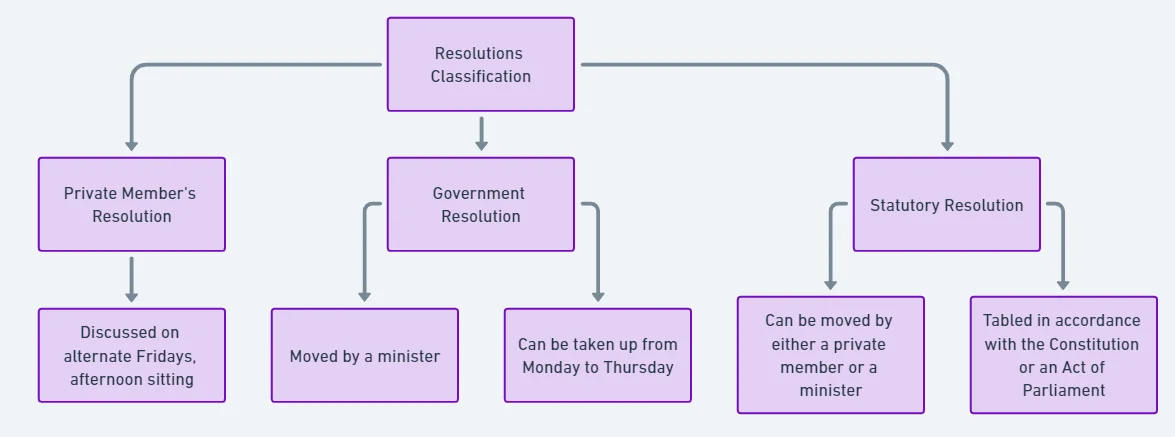This article explores the procedural devices in the Indian Parliament, focusing on significant motions and resolutions, such as Censure and No-Confidence Motions. It also examines various discussion formats and methods of parliamentary scrutiny. Understanding these mechanisms is essential for grasping how Parliament functions and holds the government accountable.
Understanding Procedural Devices in Parliament
Censure Motion vs No-Confidence Motion
| Aspect | Censure Motion | No-Confidence Motion |
| Reasons for Adoption |
|
|
| Target |
|
|
| Purpose |
|
|
| Consequence if Passed |
|
|
Enroll now for UPSC Online Course
Resolutions
- Definition: A resolution is an independent, self-contained proposal that is brought before the House for approval. It is written in a way that allows the House to express its decisions.
- All resolutions are substantive motion.
- Purpose of Proposing Resolutions: Members have the ability to propose resolutions to highlight issues of widespread public concern to the House or the government.
- Debate Regulations: Any debate on a resolution must be directly related to its content and limited to its scope.
- Withdrawal of Resolutions: Once a member proposes a resolution or an amendment to it, they can only retract it with the House’s permission.

Objectives of Resolution
- Expressing an opinion or making a recommendation.
- Recording approval or disapproval by the House of a government act or policy.
- Conveying a message or endorsing, urging, or requesting a specific action.
- Drawing attention to a matter or situation for consideration by the government.
Resolutions Classification

- Private Member’s Resolution: It refers to a resolution proposed by a member who is not a minister. It is deliberated upon only on alternate Fridays during the afternoon sitting.
- Government Resolution: It is introduced by a minister and falls into three categories:
- Resolutions endorsing international treaties, conventions, or agreements in which the government is a participant.
- Resolutions declaring or endorsing specific government policies.
- Resolutions approving recommendations put forth by certain committees.
- Statutory Resolution: These can be initiated by either a private member or a minister.
- Its name stems from its alignment with a provision in the Constitution or an Act of Parliament.
Difference between a Motion and a Resolution
| Aspect | Resolutions | Motions |
| Category | Substantive motion | Can be substantive or non-substantive |
| Nature | Every resolution is a specific type of motion | Not all are substantive; variety in types |
| Requirement for Voting | Must be voted upon by the House | Not all motions require a vote by the House |
Other Devices are Special Mentions (Matters under Rule 377)
- Scope of Rule 377: After the laying of papers, matters which cannot be raised under the Rules relating to Short Notice Questions, Calling Attention, Motions, etc. can be raised under Rule 377.
- Individual Capacity of MPs: MPs may raise issues under this Rule, in their individual capacity, with the consent of the Speaker.
- Notice Requirements: Notice needs to be given before 10 am on the day of the sitting and the text of the notice cannot exceed 250 words.
- Daily Limit and Selection of MPs: Presently 20 MPs are allowed to raise matters under Rule 377 per day.
- The names of the MPs are selected on the basis of the strength of parties in the House.
- Weekly Limitation on Matters: A member can raise only one matter under Rule 377 during a week.
- Example: In the 17th Lok Sabha, a range of matters have been raised, such as the setting up of new schools and railway lines.
Half-an-Hour Discussion (Rule 55)
- Purpose of Half-an-Hour Discussion: Where an answer to a starred or unstarred question needs further explanation, an MP may raise a half-an-hour discussion.
- Notice Requirements: He must table a notice three days in advance, stating reasons for raising a half-an-hour discussion.
- The Speaker may allow such a notice at his/her discretion.
- Participation by Other MPs: A maximum of four other MPs can raise further questions during this time.
- Example: In the 16th Lok Sabha, some of the topics discussed under half-an-hour discussions included the Pradhan Mantri Gram Sadak Yojana, irregularities under MGNREGS, and a rise in the price of milk.
Short Duration Discussion (Rule 193)
- Duration: Its period can range from one hour to two hours.
- Frequency and Approval: Usually, it is allowed by the speaker for 2 days in a week to raise any issue of public importance.
- Minister’s Response: The Minister-in-charge responds at the end of the discussion.
- Examples: Some of the major issues discussed in the 16th Lok Sabha were the agrarian crisis in the country, inflation, and various natural calamities.
Rule 184
- Procedure Similarity to Rule 193: The procedure for taking up an issue under this Rule is similar to that of Rule 193, with one exception.
- Form of Motion: The issue is raised in the form of a motion.
- After the Minister’s reply, the House votes on the motion.
- Example: in the 15th Lok Sabha, motions were raised to require the government to take steps to contain inflation (motion adopted) and to disapprove Foreign Direct Investment in retail (motion denied).
|
Enhancing Parliamentary Scrutiny: Methods, Challenges, and the Way Forward
-
Methods of Scrutiny
-
-
- Discussion/Debate : Pointing out issues during legislative discussions
- Question Hour : Questions on administration and government activity
- Parliamentary Committees : Scrutinizing Bills through specialized committees
- Finance Committees : Reviewing budgetary estimates and annual audit reports
- Ad-hoc Committees : Examining regulators’ workings
-
-
Reasons for Ineffectiveness
-
-
- Decreased Sessions : E.g. truncated sessions due to COVID-19
- Disruptions : Question Hour often disrupted
- Bypassing Committees : Fewer Bills referred to committees in recent times
- Lack of Opposition Leadership : No effective leader to challenge government
-
-
Importance of Question Hour
-
-
- Ensures Accountability & Transparency : Covers all aspects of government activity
- Government Accountability : Reveals the government’s performance and stance
- Addressing of Questions : Precision and scope for wider debates
- Defining Government’s Stand : Communicating the government’s position publicly
-
-
Way Forward
-
- Restoration of Parliamentary Practices : Avoid restricting Question Hour and Zero Hour Further
- Periodical Examination : NCRWC recommends reviewing DRSCs’ relevance
- Establishment of New Committees : Address complexities in economy and technology
- Discussion of Committee Reports : Especially when differing from government views
- Proactive Opposition : Vigilant in questioning government actions
- Inclusion of Evaluation in Reports : As per 2nd ARC, include agreed evaluation parameters
- MP Support : Provide expert resources for effective scrutiny
- Responsibility and Rule Amendments : Ensure major Bills are reviewed by DRSCS
Enroll now for UPSC Online Course
| Must Read | |
| Current Affairs | Editorial Analysis |
| Upsc Notes | Upsc Blogs |
| NCERT Notes | Free Main Answer Writing |
Conclusion
The effectiveness of parliamentary procedures is crucial for maintaining a healthy democracy.
- While devices like motions, resolutions, and discussions play a vital role, challenges such as reduced session days and disruptions hinder effective scrutiny.
- A proactive approach from all members can enhance accountability and ensure that the government remains responsive to public needs.
Sign up for the PWOnlyIAS Online Course by Physics Wallah and start your journey to IAS success today!
| Related Articles | |
| Constitution: A Living Document | 2024 Lok Sabha Election Results Live Updates |
| No Confidence Motion | Indian Parliament |

 GS Foundation
GS Foundation Optional Course
Optional Course Combo Courses
Combo Courses Degree Program
Degree Program












